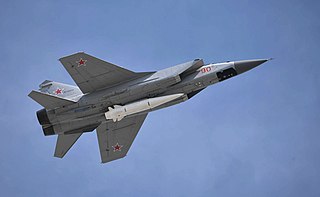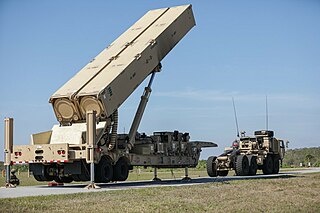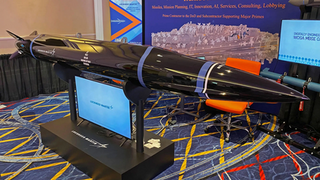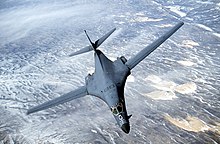
The AGM-88 HARM is a tactical, air-to-surface anti-radiation missile designed to home in on electronic transmissions coming from surface-to-air radar systems. It was originally developed by Texas Instruments as a replacement for the AGM-45 Shrike and AGM-78 Standard ARM system. Production was later taken over by Raytheon Corporation when it purchased the defense production business of Texas Instruments.

The AGM-65 Maverick is an air-to-ground missile (AGM) designed for close air support. It is the most widely produced precision-guided missile in the Western world, and is effective against a wide range of tactical targets, including armor, air defenses, ships, ground transportation and fuel storage facilities.

The Rockwell B-1 Lancer is a supersonic variable-sweep wing, heavy bomber used by the United States Air Force. It has been nicknamed the "Bone". It is one of the Air Force's three strategic bombers, along with the B-2 Spirit and the B-52 Stratofortress, as of 2024. Its 75,000-pound payload is the heaviest of any U.S. bomber.

A cruise missile is an unmanned self-propelled guided vehicle that sustains flight through aerodynamic lift for most of its flight path and whose primary mission is to place an ordnance or special payload on a target. Cruise missiles are designed to deliver a large warhead over long distances with high precision. Modern cruise missiles are capable of traveling at high subsonic, supersonic, or hypersonic speeds, are self-navigating, and are able to fly on a non-ballistic, extremely low-altitude trajectory.
The Joint Direct Attack Munition (JDAM) is a guidance kit that converts unguided bombs, or "dumb bombs", into all-weather precision-guided munitions. JDAM-equipped bombs are guided by an integrated inertial guidance system coupled to a Global Positioning System (GPS) receiver, giving them a published range of up to 15 nautical miles (28 km). JDAM-equipped bombs range from 500 to 2,000 pounds. The JDAM's guidance system was jointly developed by the United States Air Force and United States Navy, hence the "joint" in JDAM. When installed on a bomb, the JDAM kit is given a GBU identifier, superseding the Mark 80 or BLU nomenclature of the bomb to which it is attached.

The AGM-158 JASSM is a low detection standoff air-launched cruise missile developed by Lockheed Martin for the United States Armed Forces. It is a large, stealthy long-range weapon with a 1,000-pound (450 kg) armor piercing warhead. It completed testing and entered service with the U.S. Air Force in 2009, and has entered foreign service in Australia, Finland, and Poland as of 2014. An extended range version of the missile, the AGM-158B JASSM-ER, entered service in 2014 as well as an anti-ship derivative, the AGM-158C LRASM, in 2018. By September 2016, Lockheed Martin had delivered 2,000 total JASSMs comprising both variants to the USAF.

The Boeing X-51 Waverider is an unmanned research scramjet experimental aircraft for hypersonic flight at Mach 5 and an altitude of 70,000 feet (21,000 m). The aircraft was designated X-51 in 2005. It completed its first powered hypersonic flight on 26 May 2010. After two unsuccessful test flights, the X-51 completed a flight of over six minutes and reached speeds of over Mach 5 for 210 seconds on 1 May 2013 for the longest duration powered hypersonic flight.

Hypersonic flight is flight through the atmosphere below altitudes of about 90 km at speeds greater than Mach 5, a speed where dissociation of air begins to become significant and high heat loads exist. Speeds over Mach 25 have been achieved below the thermosphere as of 2020.

The Boeing B-52 Stratofortress is an American long-range, subsonic, jet-powered strategic bomber. The B-52 was designed and built by Boeing, which has continued to provide support and upgrades. It has been operated by the United States Air Force (USAF) since the 1950s, and NASA for over 40 years. The bomber can carry up to 70,000 pounds (32,000 kg) of weapons and has a typical combat range of around 8,800 miles (14,200 km) without aerial refueling.

The AGM-158C LRASM is a stealth air launch anti-ship cruise missile developed for the United States Air Force and United States Navy by the Defense Advanced Research Projects Agency (DARPA). Derived from the AGM-158B JASSM-ER, the LRASM was intended to pioneer more sophisticated autonomous targeting capabilities than the U.S. Navy's current Harpoon anti-ship missile, which has been in service since 1977.

A hypersonic glide vehicle (HGV) is a type of warhead for ballistic missiles that can maneuver and glide at hypersonic speed. It is used in conjunction with ballistic missiles to significantly change their trajectories after launch. The concept of HGVs is similar to MaRVs, but HGVs are separated from their rocket boosters shortly after launch as opposed to MaRVs which can only maneuver just before the impact. Conventional ballistic missiles follow a predictable ballistic trajectory and are vulnerable to interception by the latest anti-ballistic missile (ABM) systems. The in-flight maneuverability of HGVs makes them unpredictable, allowing them to effectively evade air defenses. As of 2022, hypersonic glide vehicles are the subject of an arms race.

The Northrop Grumman B-21 Raider is an American strategic bomber under development for the United States Air Force (USAF) by Northrop Grumman. As part of the Long Range Strike Bomber (LRS-B) program, it is to be a long-range, stealth intercontinental strategic bomber for the USAF, able to deliver conventional and thermonuclear weapons. The Air Force intends the B-21 to replace the Rockwell B-1 Lancer and Northrop Grumman B-2 Spirit by 2040, and possibly the Boeing B-52 Stratofortress after that.
The AGM-181 Long Range Stand Off Weapon (LRSO) is a nuclear-armed air-launched cruise missile under development by Raytheon Technologies that will replace the AGM-86 ALCM.

The Kh-47M2 Kinzhal is a Russian hypersonic air-launched ballistic missile. It has an estimated range of 460–480 km (290–300 mi) and a reported top speed of Mach 10. It can carry either conventional or nuclear warheads and can be launched by Tu-22M3 bombers, MiG-31K interceptors, or modified Su-34 fighter-bombers. It is the first hypersonic weapon used.

A hypersonic weapon is a weapon capable of travelling at hypersonic speed, defined as between 5 and 25 times the speed of sound or about 1 to 5 miles per second.

The Long-Range Hypersonic Weapon (LRHW) is a medium-range surface-to-surface hypersonic weapon being developed for use by the United States Army. The United States Navy intends to procure a ship/submarine-launched variant of the missile as part of the service's Intermediate-Range Conventional Prompt Strike (IRCPS) program. The weapon consists of a large rocket booster that carries the unpowered Common-Hypersonic Glide Body (C-HGB) in a nose cone. Once the booster reaches significant altitude and speed, it releases the C-HGB, which glides at hypersonic speeds as it descends towards its target. Dynetics will build the hypersonic glide vehicle while Lockheed Martin will build the booster as well as assemble the missile and launch equipment.

The Hypersonic Air-breathing Weapon Concept is a scramjet powered hypersonic air-launched cruise missile project at the U.S. Defense Advanced Research Projects Agency (DARPA), that had a successful hypersonic flight announced in September 2021. It is a kinetic energy weapon, without an explosive warhead.

Operational Fires is a hypersonic ground-launched system developed by DARPA for the United States Armed Forces. The system deploys a boost glide vehicle. The prime contractor for the program is Lockheed Martin. The missile's range is thought to be up to 1,000 miles.
The Hypersonic Attack Cruise Missile (HACM) is a scramjet-powered hypersonic air-launched cruise missile project, the successor of the Hypersonic Air-breathing Weapon Concept (HAWC) and the SCIFiRE hypersonic programs.

The Mako Multi-Mission Hypersonic Missile is a stand-off hypersonic air-launched missile developed by Lockheed Martin and CoAspire, specifically designed to fit in the internal weapons bay of the F-35A and F-35C. It is the first hypersonic weapon compatible with a fifth-generation fighter. The missile was unveiled in April 2024 at the Navy League’s Sea Air Space exposition in Maryland, with Lockheed Martin pitching it to both the U.S. Navy and Air Force. It has also been considered for deployment on submarines and surface warships.


















